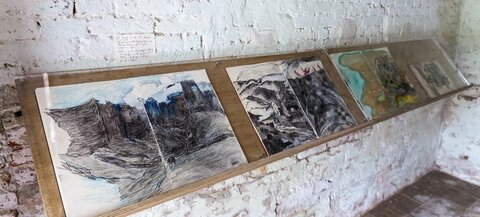Armenity/Hayoutioun
Last updated on Wed 6 May, 2015


THE NATIONAL PAVILION OF THE REPUBLIC OF ARMENIA
AT THE 56TH INTERNATIONAL ART EXHIBITION,
LA BIENNALE DI VENEZIA - 2015
ON THE ISLAND OF SAN LAZZARO DEGLI ARMENI, VENICE
Contemporary artists from the Armenian Diaspora
Haig Aivazian, Lebanon; Nigol Bezjian, Syria/USA; Anna Boghiguian Egypt/Canada; Hera
Büyüktaşçıyan, Turkey; Silvina Der-Meguerditchian, Argentina/Germany; Rene Gabri &
Ayreen Anastas, Iran/Palestine/USA; Mekhitar Garabedian, Belgium; Aikaterini Gegisian,
Greece; Yervant Gianikian & Angela Ricci Lucchi, Italy; Aram Jibilian, USA; Nina
Katchadourian, USA/Finland; Melik Ohanian, France; Mikayel Ohanjanyan, Armenia/Italy;
Rosana Palazyan, Brasil; Sarkis, Turkey/France; Hrair Sarkissian, Syria/UK.
Curated by Adelina Cüberyan v. Fürstenberg*
Press preview: May 6, 2015 at 5 pm
Opening: May 6, 2015 from 6 to 8.30 pm
In this symbolic year 2015, on the occasion of the one hundredth commemoration of the Armenian Genocide, the Ministry of Culture of the Republic of Armenia has dedicated its pavilion at the 56th International Art Exhibition of la Biennale di Venezia to the artists of the Armenian diaspora. It will be located at the Mekhitarist Monastery on the island of San Lazzaro degli Armeni. Vaporetti will leave for San Lazzaro every early afternoon from the Giardini.
The curatorial concept of Armenity** implies the notion of displacement and territory, justice and reconciliation, ethos and resilience. Regardless of their place of birth, the selected artists carry within their identity the memory of their origins. Through their talent and willpower, these grandchildren of survivors of the Armenian Genocide—the first genocide of the 20th Century— rebuilt a “transnational assembly” from the remnants of a shattered identit y. Their ingrained concern for memory, justice and reconciliation skillfully transcends notions of territory, borders and geography. Whether they were born in Beirut, Lyon, Los Angeles, or Cairo and wherever they may reside, these global citizens constantly question and reinvent their armenity.
Armenity** is being held in a setting of special significance for the Armenian diaspora. It was on the Island of San Lazzaro, located between San Marco and the Lido and facing the Giardini of the Biennale, that in 1717 the Armenian monk Mekhitar established the Mekhitarist Order. It was here that in the early 19th century Lord Byron studied the Armenian language. Many important works of European literature and religious texts were first translated into Armenian on this scenic island. Over its three-hundred years history the Monastery of San Lazzaro with its gardens, former print shop, cloisters, museum and library, has helped to preserve Armenia’s unique cultural heritage, much of which might otherwise have been lost.
An accompanying catalogue published by Skira, Milan will contain colour reproductions and texts in English and Armenian. An introduction, forewords and curatorial texts will be followed by 4 pages dedicated to each of the 16 artists: 1 page of text by each artist and essays by international art critics and writers such as Ruben Arevshatyan, Cecile Bourne, Ginevra Bria, Adam Budak, David Kazanjian, Berthold Reiss, Gabi Scardi, Hrag Vartanian and 3 pages with images and drawings of the works.
The third part of the catalogue will contain essays by New York-based art historian and independent curator Neery Melkonian and London-based art writer and Ibraaz editor Stephanie Bailey. The catalogue will end with the Armenian translations of the texts.
A book of poetry comprising the work of 12 Armenian poets born after the Armenian Genocide and the Russian Revolution will accompany the catalogue. The poems have been translated into French by the prominent Swiss-Armenian poet Vahé Godel. The book will include an essay by the author, along with a selection of Armenian translations.
In the context of Armenity, the Piccolo Amphitheater of the Arsenale will host from September 5 to 11 a series of performances, discussions and video projections by performing artists, poets and independent filmmakers orginally from Asia Minor.
The Lyon-based Bullukian Foundation*** is proud to be a partner of Armenity.
Special thanks to the Hrechdakian family (also the main supporters of the Houshamadyan Project)
We thank the Harry Babikian family, Brussels for donating the IP video surveillance system, the Boghossian Foundation, Brussels, the Foundation Alliance, Paris, the Foundation Armenia, Geneva, the UGAB, NY and Vahé Gabrache and Jean Altounian for their collaboration and support.
Press Contact:
Lucia Crespi Milan, tel +39 02 89415532 - +39 02 89401645, +39 338 8090545 -
[email protected] / [email protected]
* Adelina Cüberyan v. Fürstenberg, a Swiss citizen of Armenian origin, is a renowned international
curator. A pioneer in the field, she is known for broadening contemporary art to include a multicultural
approach. She is the founder and first Director of the Centre d’Art Contemporain de Genève and the
former Director of MAGASIN--Centre National d’Art Contemporain in Grenoble. In 1996 she founded ART
for The World, an NGO working with contemporary art, independent cinema and human rights.
** Armenity derives from the French word Arménité, a notion which expresses the particular
characteristics of the grandchildren of Armenian Genocide survivors. These include a state of constant
flux, a diversity of self-definition, and a modern and often subjective sense of being-in-the-world.
***Located at 26 Place Bellecour in Lyon, the Bullukian Foundation is known for its work ensuring the
public good and for providing shelter and aid to those in need. Faithful to its founder Napoléon Bullukian’s
vision, the foundation works mainly in the following three fields: medicine (health and cancer research); culture (more specifically by helping young artists); and Armenian social work.)




